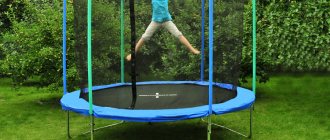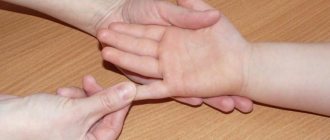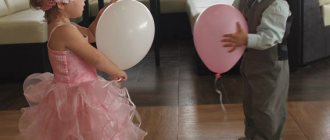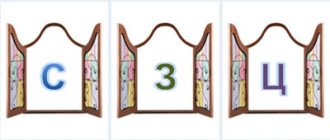Typical speech disorders in children 5-6 years old
Most older preschoolers have difficulties with:
- mastering sonorous and hissing sounds;
- sound analysis of words;
- development of narrative speech;
- writing a story and descriptions.
Of course, such problems can be minor, only slightly different from the age norm, or serious, up to and including general speech underdevelopment (GSD). It is necessary to contact a speech therapist in any case, but the supportive work of parents at home is also very important.
It is worth noting that regular speech therapy exercises and classes for children 5-6 years old are useful for every child at home, because they help to master literacy faster.
TASK No. 4
1.
Call him affectionately.
cucumber - cucumber
| pumpkin - | turnip - | tomato - |
| pepper - | squash - | garlic - |
| onion - | radish - | beet - |
| carrot - | cabbage - | eggplant - |
| potato - | zucchini - |
2.
Remember and name it.
1. Which vegetables do we eat “roots”, which ones have leaves, and which ones have fruits?
2. Which vegetables do we pick, which ones do we cut, which ones do we dig up, which ones do we pull out of the ground?
3. Which vegetables do we eat raw, which ones do we cook, fry, or preserve for the winter? What vegetables can you make juice from?
3.
Determine the place of the sound [r] in the word (orally).
| frame | cottage cheese | tomato |
| trough | motor | tent |
| bed | tap | giraffe |
| threshold | palace | cartridge |
4.
Come up with 2-3 sentences about autumn and write them down.
Remember that the first word in a sentence is written with a capital letter, and a period is placed at the end. 5.
What makes September specially different from other autumn months?
Rules for speech therapy classes at home
The success of home lessons depends not only on the availability of the necessary aids and a work plan agreed upon with the speech therapist. The organization of classes itself is very important. Here are a few simple rules that will help you achieve excellent results:
- All speech therapy exercises for children should be carried out regularly, but a little at a time. You shouldn’t try to do articulation gymnastics, play speech games, or fill out a workbook right away. It is better to devote a few minutes to each type of exercise, rather than having a whole “speech therapy day.”
- Do not force them to complete tasks under pressure; educational activities for children should resemble a game. Come up with a simple plot (for example, a journey into the universe of sounds), prepare small prizes (stickers, paper stars), and arrange physical exercises.
- Praise and support the little student if he makes even the slightest progress. Focus on achievements, even small ones, gradually progress will become more and more obvious.
- Find good workbooks for home practice. They should not only be professional in content, but also bright, colorful, and exciting. It is ideal if the tasks have interactive elements (the opportunity to add something, draw something). Such material makes it possible to interest a preschooler and clearly shows him the “path traveled” and success.
- Don't expect instant results, be patient and gentle perseverance. The process of setting, consolidating, and differentiating sounds is complex; it takes months even for experienced speech therapists. Follow the plan and the results will gradually appear.
Entertaining developmental tasks in classes with a speech therapist
Svetlana Laguteeva
Entertaining developmental tasks in classes with a speech therapist
The main task of a speech therapist in elementary school is to provide assistance to students who have disorders in the development of oral and written speech and experience difficulties in learning and communication. The results of activities directly affect the quality of training in literary reading, the Russian language, and the surrounding world, which is fundamental for the further acquisition of knowledge by students.
on how classes , what methods and techniques a specialist uses when working with primary schoolchildren.
A first-grader who came to school in September is the same preschooler. He has not yet gotten used to the new conditions, has not realized the stage of transition to a new level of his life, has not become familiar with the rules and requirements. In order to make a smooth transition to school, and not aggravate existing developmental , we select exercises that will help the child smoothly and painlessly enter educational activities. When selecting tasks and planning a lesson, we take into account the student population, recommendations for organizing speech therapy work, and are based on diagnostic results.
Our classes in elementary school are based on the type of game trips, entertaining investigations with solving puzzles, rebuses, etc. At the first stage of work, we intensively direct our activities to overcome phonetic-phonemic disorders, mastery of basic concepts and orientation in schematic images of words, sounds, offers, etc.
We master the skill of sound analysis of a word, consolidate the graphic representation of letters, and develop calligraphic skills.
We consider the basis of the initial work to be the development of fine motor skills of the fingers, general motor skills and movements, articulatory motor skills of the speech apparatus and respiratory function, etc. Games and exercises with various materials help with this: natural, plasticine and clay, counting sticks and colored sticks, physical exercises and breathing exercises, development of precise hand movements when working on points, sensory games and exercises.
Children are most interested in practical exercises where they can touch, see, smell and hear everything. It is in these exercises that the child’s sensory experience is enriched, new sensations are acquired and tactile memory arises, which helps the child in remembering the general appearance of letters, their spelling, and especially in overcoming this type of disorder such as mirror writing.
While working in class , children enthusiastically complete tasks and the skills necessary for us, specialists, are formed in the child more easily and firmly. So in our classes we lay out silhouettes of letters from stones, sticks, practice the rules of writing in
copybooks - simulators, we use a symbolic system for designating units of speech: sound, word, sentence, we use mnemonics in solving , etc. d.
During logorhythmics classes in game exercises we solve such problems as the development of general motor skills , movements, smoothness of speech breathing and exhalation force, we practice the articulation of vowel sounds in chants, we develop a sense of rhythm in dance and rhythmic exercises and games. This type of activity is very popular with children and is perceived as an entertaining activity , although we understand that these tasks are very important for children with speech development . By developing the prosodic side of speech: rhythm, tempo, timbre, pitch of voice, emotionality and brightness of speech, facial expressions and gestures, we influence the formation of general speech tone, motor skills, mood, and contribute to training the mobility of the nervous processes of the central nervous system, activating the cerebral cortex.
Taking into account the student population of our school, and the decline in memory processes characteristic of children with special needs , we use a large amount of visual and practical material, since practical methods of work help to remember and assimilate the material more firmly.
I would like to note that the most successful overcoming of speech deficiencies occurs in those children with whom the material is studied at home and the recommendations of the speech therapist . for a child who has repeated tasks and performed simple articulation and breathing games and exercises in class . Accordingly, during the lesson the child can already do some of the work independently, controls himself and works on self-development . This is how awareness is fostered in overcoming one’s problems, embarrassment and constraint before completing tasks , and the child’s interest arises.
Dear parents! We are trying for your children! We want to see you among our associates and as the first stakeholders in the development of each student. By following daily recommendations for child development , you help him cope with speech development , be successful and master the curriculum. Only through joint efforts will we achieve positive results. I wish you good luck in the development of each child .
The material was prepared by a teacher- speech therapist
MBOU "Boarding School No. 1"
Sarov
Aguteeva S.S.
Speech therapy exercises for practicing at home
All speech therapy exercises can be divided into three large blocks, each of which needs to be given attention and carried out regularly:
Development of phonemic hearing
The ability to distinguish sounds by ear seems natural, but if you ask your preschooler to spell a word, you will see gaps.
For children 5-6 years old, there are a large number of special games and exercises that help develop phonemic hearing. These include:
- selection of words starting or ending with a given sound;
- counting sounds in a word, determining the syllable structure;
- drawing up a sound diagram of a word;
- inventing rhymes and short poems;
- pronouncing speeches and tongue twisters.
Thoughtful speech therapy classes for children 5-6 years old make it possible to make all the sounds of their native language obedient and easy.
Finger gymnastics
Fine motor skills of the hands help speech activity, so older preschoolers must do it without fail.
Of course, for children 5-6 years old, the exercises should be complex, with a script, in verse. It is useful to select sets of exercises for both hands at the same time, synchronous. Don't forget to use "helpers":
- small massagers (rubber balls, rollers, cones);
- scissors for cutting;
- plasticine;
- origami paper.
Also remember that all types of needlework, construction, and any creativity are great ways to improve fine motor skills outside of individual lessons.
Articulation gymnastics
Special language exercises must be performed every day if there are any problems with pronunciation. For home exercises, it is best to choose a set of exercises with a poetic description and pictures.
Do a tongue warm-up every day, always in front of a mirror (this allows the baby to observe the process himself, assessing its success). If you have problems with one or two sounds, then articulatory gymnastics should be selected for them. These can be found in thematic workbooks on speech therapy.
TASK No. 3
1.
Change the words according to the model.
cucumber - (they are) cucumbers, (many) cucumbers
tomato —
pumpkin
-
zucchini
-
turnip
-
eggplant
-
onion
-
2.
Name the tree trunk based on the model.
For 2nd grade students: do this task orally.
For 3rd grade students: write down the resulting phrases in your notebook.
birch trunk
(what?)
- birch
| oak trunk - | poplar trunk - |
| aspen trunk - | cedar trunk - |
| rowan tree trunk - | willow trunk - |
| maple trunk - | linden trunk - |
3.
Show your right hand first, then your left.
Tell us what a person does with his right hand and what he does with his left hand. Look around. What objects are on your right side? And on the left side? 4.
Name the deciduous trees of our country.
What happens to trees in the fall? Why do you think the leaves fall from the trees in the fall? Highlight the first and last sounds in the word name of each tree. 5.
Name the objects superimposed on each other.
Speech therapy tasks
Starting with the letter R
One of the most difficult sounds to master is R. Many preschoolers learn to roar loudly by the very end of kindergarten. If the production of the sound P is already behind you, then special exercises will help speed up its automation:
1. “Like a little motor”
We ask the child to pronounce the sound R in the word for a long time, drawlingly (like a motor growls).
2. “Where is R hiding?” (in pictures and words)
Offer to choose pictures with images of objects with a given sound or clap your hands if he hears such a word.
3. “How can you growl?”
Show your child pictures of objects that have the sound r in their names. Offer to read and color the picture.
4. “Sounding tracks”
Together with your child, come up with several chants made up of several syllables:
Ra-ra-ra - they ran away from the yard.
Ro-ro-ro - and they found a bucket.
Ru-ru-ru - we came up with a game.
5. “Substitute a syllable”
The adult offers the child words that end or begin with a syllable with P (ra, ro, ry), the child must choose the correct option and pronounce it correctly.
6. “Look and name”
An adult asks the child to read words with the letter r from the pictures. The word must be said as many times as there are stars next to each picture.
7. “Poems, tongue twisters, riddles”
Learn with your child several poems and riddles in which words with R appear.
The necessary tasks for speech development can be found in the Workbook for the sound R, compiled by Kostyuk A.V.
Download, print the tasks in pictures and study at home:
Speech therapy tasks for the letter P
Starting with the letter L
The hard sound L is also often difficult for children 5-6 years old. If the baby has already learned to pronounce it alone, in isolation, then it’s time to start working on automation in speech. The following exercises are suitable for this:
1. “Say it nicely”
Offer your child several images of words starting with L. Ask him to pronounce the words beautifully, emphasizing the desired sound with his voice.
2. “Toys for Larisa”
Ask your child to collect gifts for the Larisa doll. Tell her that she only likes things that begin with L. For this exercise, you need to select small objects or pictures in advance; all words should not begin only with L.
3. “One-many”
Invite your child to name words with L in the singular and plural. In the workbook for the sound L (author Kostyuk A.V.) there is a whole table with pictures for this exercise (lesson 20).
4. “Find the Sound”
Invite your child to draw up a diagram of the word and mark the place L on it. If it is still difficult for your child to independently determine the number of sounds, then first you can do several similar exercises from the workbook.
5. “Tongue twisters and nursery rhymes”
Use nursery rhymes, tongue twisters and poems with words that contain L.
Download and print tasks in pictures starting with the letter L:
Speech therapy tasks for the letter L
TASK No. 2
1.
Name the vegetables that you know.
For 2nd grade students: draw 5-6 pictures of vegetables similar in shape to a circle, oval, or triangle. Write a title for each picture.
For 3rd grade students: write these names in your notebook.
2.
Come up with 25–30 words that begin with vowels of the first row (
a, o, u, e ). Write these words in your notebook.
3.
Think and answer. Which could be:
| autumn - | rain - |
| wind - trees - | sky - |
For example: autumn
(how am I?)
cold, ...
4.
Change the words according to the model.
| Word | what did you do? | what did you do? | what they were doing? |
| imprisoned | planted | planted | imprisoned |
| digging | |||
| watered | |||
| loosen | |||
| spud up | |||
| collect |
5.
Look at the picture and make up a story based on it (orally).
How many sentences are there in your story?
TASK No. 9
1.
Think, compose and write down a story about how you spent your summer.
| 1) Where have you been? | 4) Who did you play with? |
| 2) What did you do in the summer? 3) Who did you meet? | 5) What did you read in the summer? |
2.
Change the verbs according to the model.
what did you do?
what did you do? what they were doing? plants planted planted planted digs
- grows - waters - ripens -
3.
Find the extra word, explain why you think so.
blueberry - blueberry - ink - blueberry lingonberry - bars - lingonberry - lingonberry strawberry - dugout - strawberry - strawberry cranberry - cranberry - cranberry - cranberry
4.
Read the words, write them down, distributing them into columns (according to the number of syllables).
Arch, pocket, panda, prey, pike, hour, owl, fruit, eel, calendar, barrel, butterfly, marten, crayfish, zucchini.
5.
Solve puzzles.
TASK No. 8
1. Complete the sentences (orally).
1) The harvest was being harvested in the garden. Picked cucumbers
. There is no (...) in the garden. There is not a single one in the garden (...).
2) Collected zucchini
. There is no (...) in the garden. There is not a single one in the garden (...).
3) Collected tomatoes
. There is no (...) in the garden. There is not a single one in the garden (...).
4) Collected carrots
. There is no (...) in the garden.
5) Harvested beans
. There is no (...) in the garden.
2.
Come up with 5-6 sentences with the names of vegetables and write them down.
3.
Write down in your notebook those letters that are written correctly.
4.
Read the names of vegetables, highlight the first syllable in each.
| tomato garlic | pepper |
| cucumber pumpkin | zucchini |
| eggplant turnip | beet |
| zucchini radish | carrot |
| squash potatoes 5. What's extra? Why? | onion |
| cherry blueberry | cherry |
6. Remember 10 words each consisting of 3 sounds, 4 sounds, 5 sounds.
TASK No. 5
1.
List the fruits that you know.
For 2nd grade students: draw these fruits and write their names.
For 3rd grade students: write down the names of the fruits in your notebook.
2.
Name only fruits affectionately. apple - apple
| orange - | eggplant - | lemon - |
| cucumber - | pear - | beet - |
| radish - | pumpkin - | tomato - |
| banana - | apricot - | lime - |
| a pineapple - | garlic - | tangerine - |
| grapefruit - | pomegranate - |
3.
Answer the questions given in brackets. What fruits are there in color, taste, shape?
| lemon (what?) - | pineapple (what?) - |
| orange (what?) - | apricot (what?) - |
| apple (what?) - banana (what?) - | pear (who am I?) - |
4.
Answer the questions.
Write down a few sentences. 1) What kind of fruits are there?
2) Which ones do you like best? Why?
3) What fruits did you eat in summer?
5.
What is unnecessary here and why?
orange lemon banana
6.
Name the fruits, count the number of sounds in each word.
TASK No. 6
1.
Say and write down in your notebook the names of the berries that you know.
2.
Say a word. What is the name of the juice? apple juice
(what?) -
apple
| from lemon - | from pears - |
| from grapes - | from oranges - |
| from plum - | from peaches - |
| from apricots - | from cherries - |
3.
Guess and answer.
People are running from the street. It's bad weather outside. What happened on the street? Why do people run away?
4.
What wild berries do you know?
Name it. 5.
Say the words, identify the first and last sound in the word.
Do sounds and letters always match in a word?
| shark | cormorant | fish |
| arena | heel | splinter |
| window | noise | mountain |
| ears | garbage | I'll give it up |
| bonds | market | horses |
| willow | onion | Oak trees |
6.
Listen to the words and determine the location of the sound.
| [A] | [m] | [R] |
| cancer | reed | carpet |
| fish | noise | market |
| stingray | fly | Hurricane |
| squirrel | rumba | sulfur |










